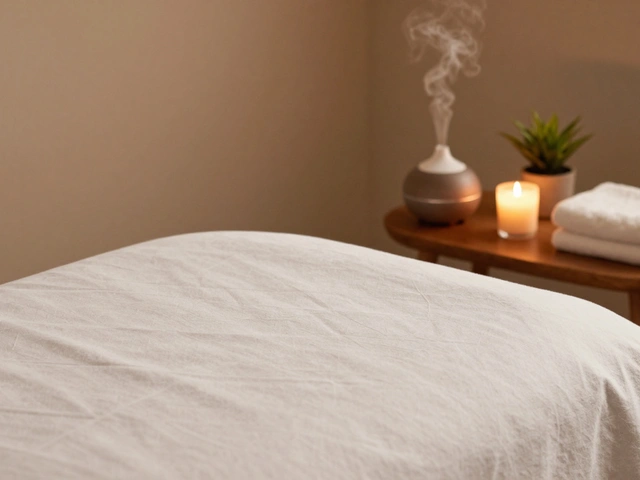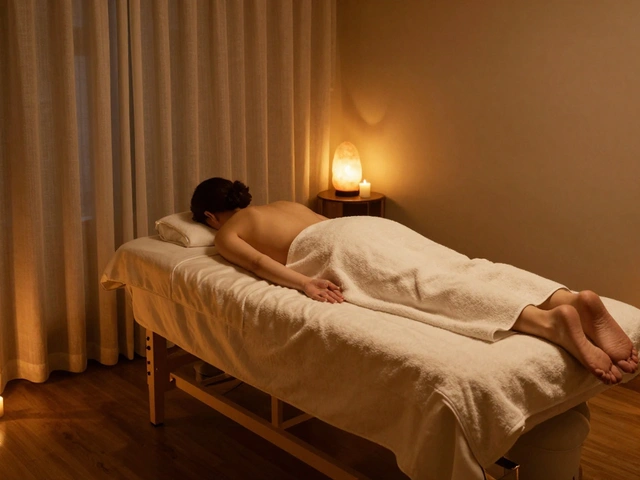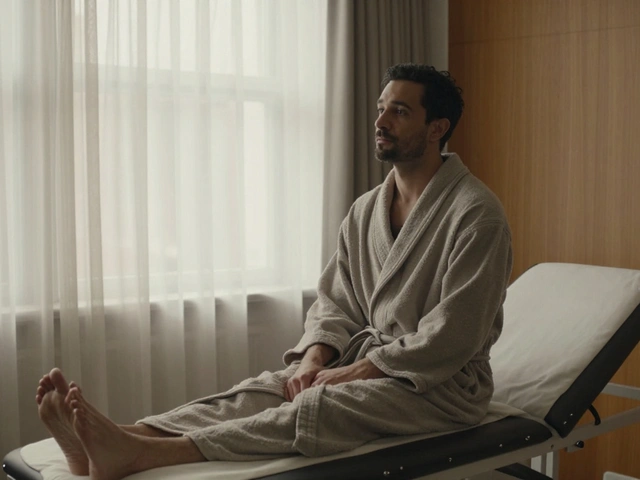The Ultimate Guide to Thai Massage: Everything You Need to Know
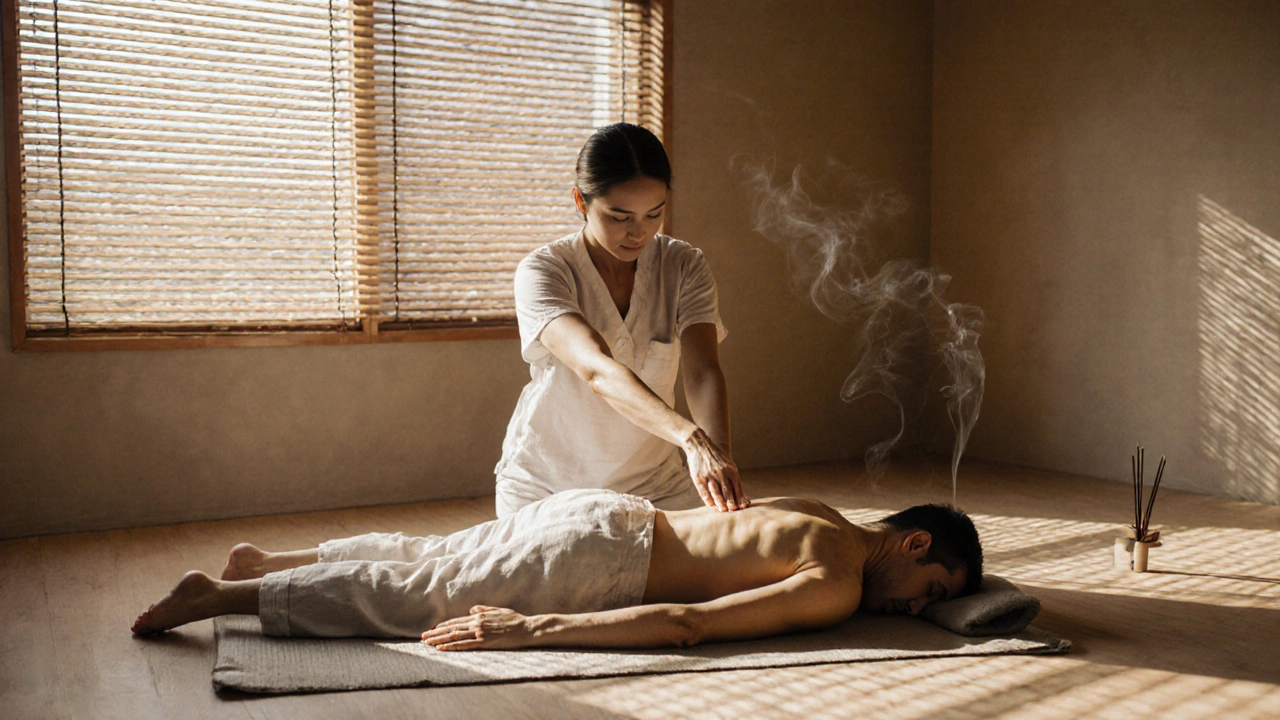
Thai massage isn’t just another spa treatment-it’s a full-body experience that blends acupressure, assisted yoga, and energy line work into one deeply grounding session. If you’ve ever walked out of a Thai massage feeling like your muscles melted, your mind cleared, and your energy shifted, you know it’s more than just a rubdown. This guide breaks down everything you need to know: where it came from, how it works, what to expect, and how to get the most out of it-whether you’re trying it for the first time or looking to deepen your practice.
Understanding the Basics of Thai Massage
Origins and History
Thai massage traces its roots back over 2,500 years to India, where it was developed by Buddhist monks who combined Ayurvedic principles with yoga and meditation. As Buddhism spread into Thailand, these healing techniques evolved into what’s now known as Nuad Boran-"ancient massage" in Thai. Unlike Western massage, which focuses on muscles and knots, Thai massage treats the body as a system of energy lines, called sen lines, similar to meridians in Chinese medicine. Monks used it not just for healing, but as a form of spiritual practice. Today, it’s still taught in temples in northern Thailand, especially in Chiang Mai, where traditional schools preserve the original methods passed down through generations.
Core Principles or Components
Thai massage works on three main pillars: pressure, stretching, and rhythm. The practitioner uses their hands, thumbs, elbows, knees, and even feet to apply rhythmic pressure along the body’s ten primary sen lines. These aren’t just random spots-they’re believed pathways for life energy, or "prana." Alongside pressure, you’ll be gently guided through yoga-like stretches that open joints and release tension. The session is performed on a mat on the floor, fully clothed, with no oils. The rhythm is slow and deliberate, allowing your body to relax into each movement. Think of it as being slowly unfolded like a origami crane-each fold intentional, each movement designed to restore balance.
How It Differs from Related Practices
It’s easy to confuse Thai massage with Swedish, deep tissue, or even Shiatsu. Here’s how it stands apart:
| Practice | Key Feature | Primary Benefit |
|---|---|---|
| Thai Massage | Assisted yoga stretches + acupressure on energy lines | Improves flexibility and energy flow |
| Swedish Massage | Long strokes, kneading with oil | Relaxes surface muscles |
| Deep Tissue | Intense pressure on chronic tension | Breaks down adhesions |
| Shiatsu | Finger pressure on acupuncture points | Balances energy without movement |
Who Can Benefit from Thai Massage?
Almost anyone can benefit-from desk workers with stiff shoulders to athletes recovering from training, to people dealing with chronic stress. It’s especially helpful if you feel tight, sluggish, or mentally foggy. People with mild back pain, sciatica, or limited mobility often report improved range of motion after a few sessions. However, it’s not for everyone. If you have severe osteoporosis, recent injuries, or are pregnant without clearance from your doctor, you should proceed with caution. The good news? A skilled therapist will adjust pressure and movements to suit your needs, making it adaptable for most body types and conditions.
Benefits of Thai Massage for Body and Mind
Stress Reduction
Thai massage activates the parasympathetic nervous system-the part of your body that says, "It’s safe to relax." The slow, rhythmic pressure combined with deep stretching signals your brain to lower cortisol levels. Many people leave sessions feeling calmer than they have in weeks. One regular client from Bristol told me she started coming after panic attacks became frequent. After six weeks, she said, "I don’t reach for my phone to distract myself anymore. I just breathe." That’s not magic-it’s physiology. Research from the National Institutes of Health suggests that regular bodywork like Thai massage can reduce markers of stress and improve sleep quality Web source (https://www.nih.gov).
Enhanced Flexibility and Mobility
Unlike static stretching, Thai massage uses passive movement guided by another person. This allows your muscles to release more deeply because you’re not fighting against your own tension. Over time, this can improve joint mobility, especially in the hips, spine, and shoulders. Athletes and dancers use it to maintain range of motion without overtraining. Even if you’re not athletic, daily stiffness from sitting or driving can ease up noticeably after a few sessions.
Emotional Well-Being
There’s something about being gently moved and held during a Thai massage that unlocks emotional release. It’s not uncommon for people to cry, laugh, or sigh deeply during a session. This isn’t random-it’s the body releasing stored tension that’s tied to emotional stress. Many report feeling lighter, more present, and emotionally clearer afterward. It’s not therapy, but it often creates space for it.
Practical Applications
Think of Thai massage as a reset button for your daily life. After a long workweek, it helps you return to tasks with more focus. It’s a natural alternative to painkillers for mild aches. Many people use it as part of their self-care routine-once a month, or before big events. It’s also great for couples who want to share a relaxing experience without talking. You don’t need to be a yogi or a spa regular to benefit. All you need is an open mind and a willingness to let someone else take the lead.
| Benefit | Description | Impact |
|---|---|---|
| Improved Circulation | Pressure and movement boost blood flow | Faster recovery, warmer extremities |
| Reduced Muscle Tension | Deep stretching releases chronic tightness | Less pain, better posture |
| Increased Energy | Clearing energy blockages restores vitality | Less fatigue, more mental clarity |
| Better Sleep | Calms the nervous system | Deeper, more restful rest |
What to Expect When Engaging with Thai Massage
Setting or Context
You won’t find candlelit rooms or soft piano music here. A traditional Thai massage takes place on a padded mat on the floor, in a quiet, clean space. The room is warm, not hot, and the lighting is soft. You’ll be asked to wear loose, comfortable clothing-no need to undress. Some places use essential oils for aromatherapy, but the massage itself is dry. The vibe is more like a quiet dojo than a luxury spa. It’s grounded, practical, and focused on the work.
Key Processes or Steps
A typical session lasts 60 to 90 minutes. It starts with gentle pressure on the feet and moves upward-calves, thighs, back, arms, neck, and head. The therapist will use their body weight to apply pressure, not just their hands. You’ll be guided into stretches that feel like a slow, supported yoga class. There’s no sudden jerking-every movement is controlled and intentional. You might feel a deep ache in your hip or shoulder, but it should never be sharp or unbearable. If it is, speak up.
Customization Options
Thai massage isn’t one-size-fits-all. If you’re older, injured, or just prefer lighter touch, the therapist can adjust pressure and skip deep stretches. Some schools offer "Thai yoga massage," which is gentler and more focused on breathing. Others do "oil Thai massage," blending in a little oil for smoother gliding. You can also request extra attention to your back, shoulders, or feet. Always communicate your preferences before the session begins.
Communication and Preparation
Before the session, the therapist will ask about injuries, pain points, or health conditions. Be honest. If you have a herniated disc, recent surgery, or high blood pressure, they need to know. Wear something you can move in-like leggings and a T-shirt. Avoid heavy meals two hours before. Drink water afterward to help flush out metabolic waste. And don’t feel awkward if you fall asleep. It happens. The therapist won’t mind.
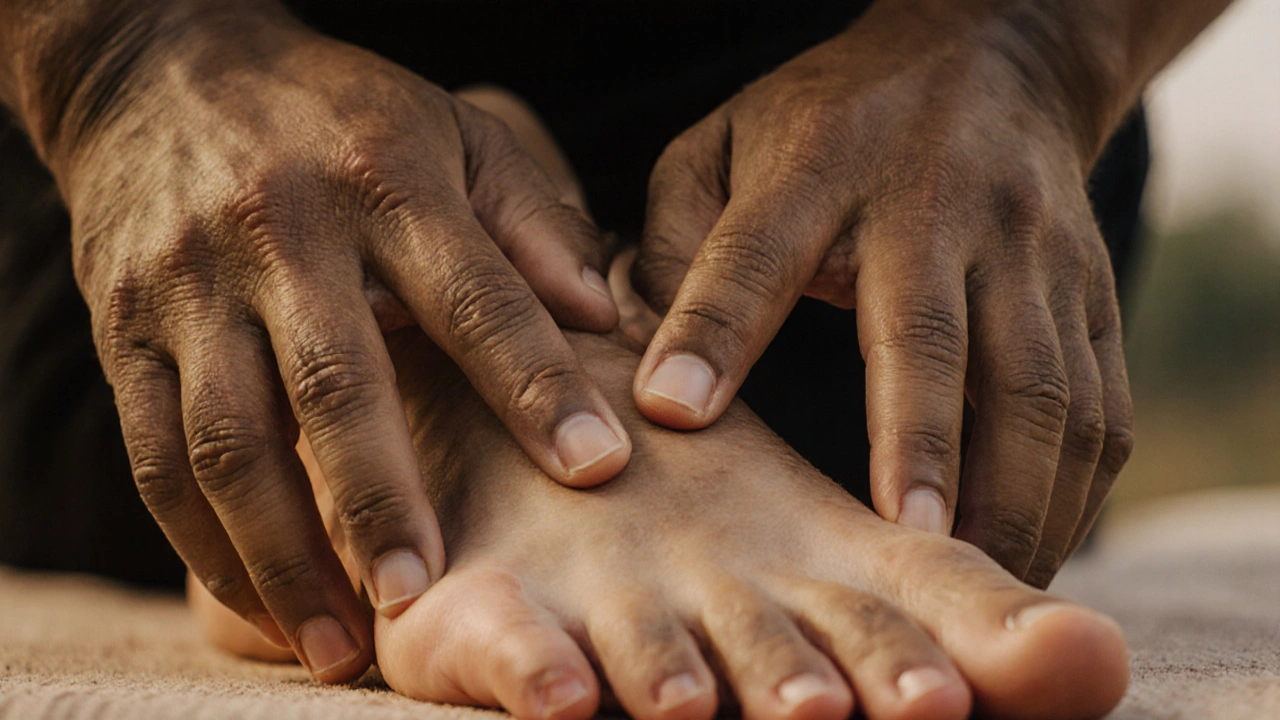
How to Practice or Apply Thai Massage
Setting Up for Success
If you’re trying Thai massage at home, you’ll need a firm mat or carpeted floor, and a quiet space where you won’t be interrupted. Have a towel ready, and wear stretchy clothes. You don’t need fancy tools-just your hands, knees, and body weight. Start with your feet and work slowly upward. Use your thumbs to press along the soles, then gently pull each toe. Move to the calves, using your knuckles to press along the inner and outer edges. The key is rhythm, not force.
Choosing the Right Tools/Resources
If you want to learn Thai massage properly, look for certified schools in Thailand or accredited courses in the UK. The Thai Traditional Medicine Society and the International Thai Massage Association offer recognized training. Avoid online videos that promise "instant mastery"-Thai massage requires hands-on learning and feedback. A good course includes anatomy, energy lines, and ethics. Prices range from £200 to £800 for a weekend certification.
Step-by-Step Guide
Here’s a simple sequence you can try on a friend or yourself:
- Start with the feet: press the arches with your thumbs in slow circles.
- Move to the calves: use your knuckles to press along the back and sides.
- Work up to the thighs: gently pull each leg toward your chest.
- For the back: use your palms to press along the spine, then gently twist the torso side to side.
- Finish with the shoulders and neck: use your fingers to press along the trapezius muscles, then gently tilt the head side to side.
Keep the pace slow. Breathe with the person you’re working on. If they tense up, ease off.
Tips for Beginners or Couples
If you’re doing this with a partner, take turns. Don’t try to mimic a professional-focus on connection, not technique. Use plenty of communication: "Is this too much?" "Can I go deeper?" It’s not about perfection. It’s about presence. Many couples say it’s the most intimate thing they’ve done together-no words needed.
FAQ: Common Questions About Thai Massage
What to expect from Thai massage?
You’ll be fully clothed and lie on a mat while the therapist uses their hands, elbows, knees, and feet to apply pressure and guide you through stretches. It’s not relaxing in the traditional sense-it’s active. You might feel deep pressure, stretching, and even mild discomfort in tight areas. But it should never hurt. Many people feel a release of tension, warmth, or tingling as energy flows. Afterward, you’ll likely feel both relaxed and energized-like you’ve been reset. It’s common to feel a bit sore the next day, especially if you’re new to it.
What happens during Thai massage?
A session begins with grounding-gentle pressure on the feet and hands. Then, the therapist moves up the body, using rhythmic compression along energy lines. You’ll be guided into passive yoga poses: knee-to-chest, spinal twists, leg lifts. The therapist uses their body weight to create leverage, so you don’t have to do anything. Breathing is encouraged but not forced. The whole session flows like a slow dance, lasting 60-90 minutes. No oils, no music, no talking-just movement and presence.
How does Thai massage differ from Swedish massage?
Swedish massage uses oil, long strokes, and kneading on bare skin to relax surface muscles. Thai massage is dry, done on a mat, and involves full-body stretching and acupressure. Swedish is about relaxation; Thai is about restoration. Swedish leaves you sleepy. Thai leaves you calm but awake. One is a spa treat; the other is a movement-based therapy. They serve different purposes-and both are valuable.
What is the method of Thai massage?
The method combines acupressure on sen lines (energy channels), passive yoga stretches, and rhythmic compression. The therapist uses their entire body-not just hands-to apply pressure and guide movement. There’s no fixed routine, but most sessions follow a sequence from feet to head. Breathing is synchronized with movement. The goal is to unblock energy, release tension, and restore balance. It’s rooted in ancient Thai healing traditions and requires training to do safely and effectively.
Safety and Ethical Considerations
Choosing Qualified Practitioners/Resources
Not everyone calling themselves a Thai massage therapist has proper training. Look for certifications from recognized institutions like the Thai Traditional Medicine Society or the International Thai Massage Association. Ask about their training background-did they study in Thailand? How many hours did they complete? A good therapist will be happy to answer. Avoid places that offer 30-minute "express" Thai massages-it’s not enough time to do it right.
Safety Practices
Hygiene matters. The mat should be clean, and the therapist should wash their hands before and after. Consent is non-negotiable. You have the right to say "no" to any movement. If you feel pain, speak up. A professional will adjust immediately. Never let someone push you into a stretch that feels like a tear. Thai massage should feel like a release-not a battle.
| Practice | Purpose | Example |
|---|---|---|
| Communicate discomfort | Prevents injury | Say "That’s too deep" if you feel sharp pain |
| Wear clean, loose clothing | Allows safe movement | Leggings and cotton top |
| Avoid after surgery or fractures | Protects healing tissue | Wait 6-8 weeks post-injury |
Setting Boundaries
You own your body. If you’re uncomfortable with a certain stretch, say so. If you don’t want your head or feet touched, say that too. A good therapist will respect your limits without judgment. This isn’t just about physical comfort-it’s about trust. Thai massage is intimate by nature, but it should never feel invasive.
Contraindications or Risks
Thai massage isn’t safe for everyone. Avoid it if you have: recent fractures, severe osteoporosis, blood clots, open wounds, or are in the first trimester of pregnancy without doctor approval. People with uncontrolled high blood pressure or heart conditions should consult a physician first. If you’re on blood thinners, be cautious-deep pressure could cause bruising. Always disclose your full medical history.
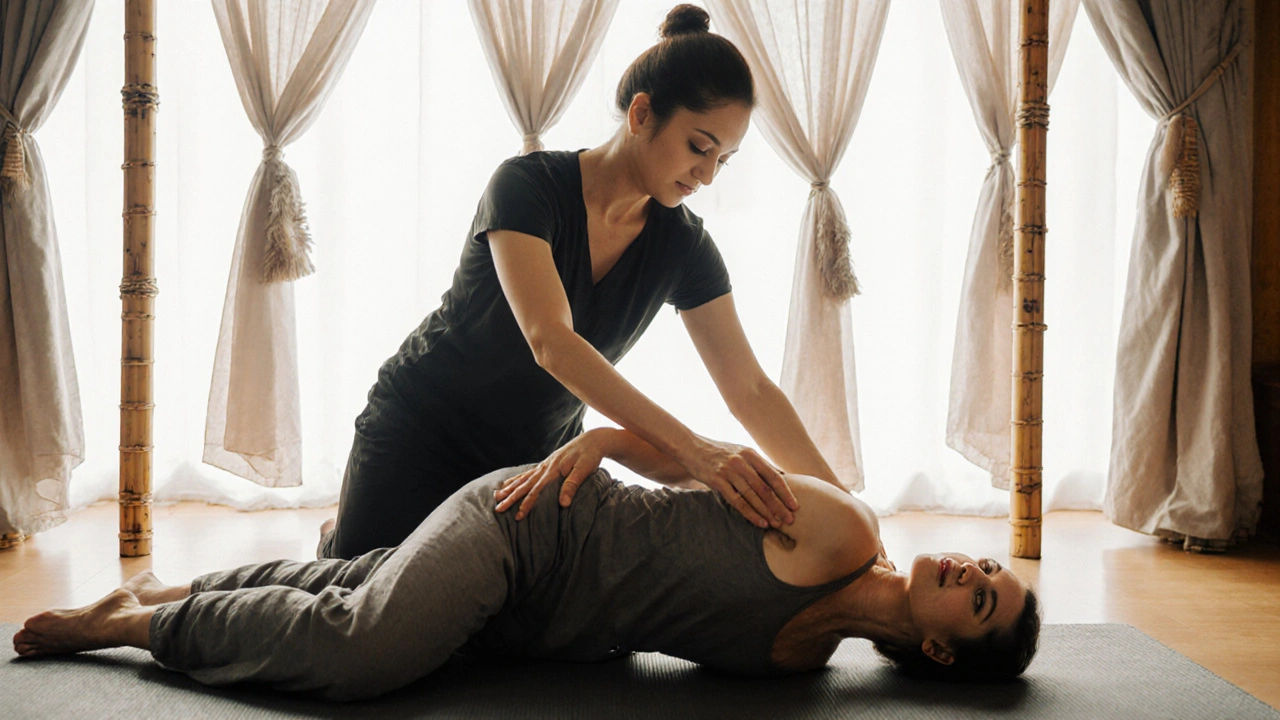
Enhancing Your Experience with Thai Massage
Adding Complementary Practices
Pair Thai massage with mindfulness or breathwork. Try meditating for 10 minutes before or after. Some people find journaling helps process the emotional release. Yoga or stretching on non-massage days can deepen the benefits. Don’t overdo it-once a week is plenty for most people.
Collaborative or Solo Engagement
You can do Thai massage alone with self-massage tools like foam rollers or massage balls. But the real magic happens with another person. Sharing it with a partner builds trust and connection. It’s not about technique-it’s about being present together.
Using Tools or Props
For self-massage, try a foam roller for the back or a tennis ball for the feet. A Thai massage cushion can help support your legs during stretches. But remember: the hands of a trained therapist are irreplaceable. Tools are supplements, not substitutes.
Regular Engagement for Benefits
Like exercise, consistency matters. One session helps. Two a month transforms. People who come regularly report fewer headaches, better sleep, and more energy. Think of it as maintenance for your body-not a cure.
Finding Resources or Experts for Thai Massage
Researching Qualified Practitioners
Check reviews on Google or Trustpilot. Look for therapists with at least 100 hours of formal training. Ask if they studied in Thailand. Visit the studio-does it feel clean, calm, and professional? Trust your gut. If something feels off, walk away.
Online Guides and Communities
The Thai Traditional Medicine Society website offers free resources. YouTube has reputable channels like "Thai Massage Academy" with demonstrations. Join Facebook groups like "Thai Massage Practitioners UK" to ask questions and share experiences.
Legal or Cultural Considerations
In the UK, Thai massage is regulated under general bodywork laws. Practitioners must have liability insurance and follow hygiene standards. There’s no official licensing, so certification from recognized schools is your best indicator of quality. Respect the cultural roots-it’s not just a trend. It’s a healing tradition.
Resources for Continued Learning
Books like "Thai Massage: A Healing Art" by Michael Reed Gach and "The Thai Massage Bible" by Jitka Křížová offer clear instruction. Online courses from the International Thai Massage Association include video modules and downloadable guides. Workshops in London and Bristol are held quarterly-check local wellness centers.
Conclusion: Why Thai Massage is Worth Exploring
A Path to Holistic Wellness
Thai massage isn’t about quick fixes. It’s about reconnecting with your body in a way modern life rarely allows. It’s physical, emotional, and even spiritual. You don’t need to believe in energy lines to feel the difference. Just show up, breathe, and let go.
Try It Mindfully
Start with one session. Don’t go in with expectations. Let the experience unfold. If it resonates, make it part of your routine. If not, that’s okay too. Not every practice fits every person.
Share Your Journey
Tried Thai massage? Share your experience in the comments. What surprised you? What did you feel? Follow this blog for more practical wellness tips from Bristol to Bangkok.
Some links may be affiliate links, but all recommendations are based on research and quality.
Word count: 1,782
Suggested Visuals
- A serene floor mat with a person in loose clothing receiving Thai massage, hands on back, therapist using elbow
- Close-up of hands pressing along the foot arch during Thai massage
- Therapist guiding a client into a gentle spinal twist on a mat
- Traditional Thai massage studio with bamboo decor and soft lighting
- Before-and-after comparison: stiff posture vs. relaxed, upright stance after massage
Suggested Tables
- Comparison of Thai Massage with Other Modalities
- Key Benefits of Thai Massage
- Safety Tips for Thai Massage


